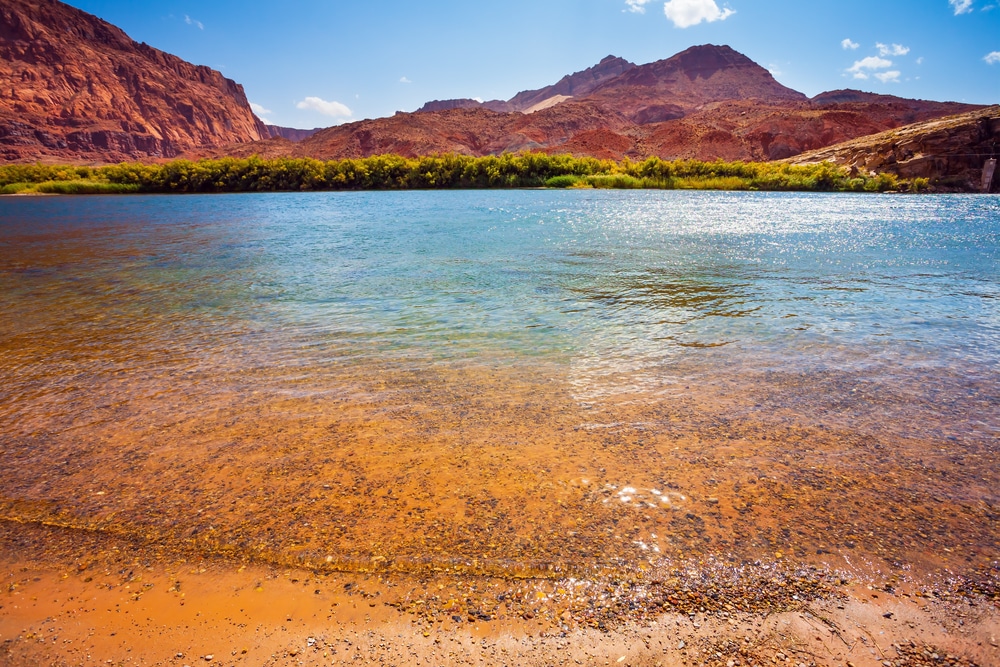The wind whispers through cottonwood trees as the Colorado River cuts through the vermilion cliffs, carving its path as it has for millennia. Here, at this remote crossing between worlds, the remnants of Lee’s Ferry stand in quiet testament to human determination and frontier aspiration. Sandstone buildings, weathered by time, watch over the placid waters that once represented both opportunity and peril for Arizona’s early settlers. Near these ruins, a small cemetery sits on higher ground—a collection of weathered markers and simple stones that tell stories of lives lived in one of Arizona’s most isolated yet historically significant outposts.
Located in northern Arizona near the Utah border, Lee’s Ferry marks the only place within hundreds of miles where travelers could cross the Colorado River. This geographic happenstance made it a crucial waypoint in Arizona’s development, a natural gateway between north and south that would shape migration patterns, communication routes, and eventually transportation networks across the Southwest.

Lee’s Ferry is famously known as the official starting point for rafting trips through the Grand Canyon. Whether you’re a licensed guide or joining a commercial outfitter, this is where epic multi-day adventures into the canyon begin. Even if you’re not rafting, it’s exciting to watch expeditions launch from the riverbank.
Established by Mormon settler John D. Lee in 1870, Lonely Dell Ranch was home to the Lee family and early ferry operations. You can tour the restored ranch house, orchards, and cemetery, and walk through the Stone Fort, which once offered refuge from local conflicts. Interpretive signs explain the challenges of life at this remote outpost.
Just a few minutes from Lee’s Ferry is the Navajo Bridge Interpretive Center, where visitors can walk the historic bridge spanning the Colorado River. The views down into Marble Canyon are breathtaking, and it’s a great spot to watch for California condors soaring overhead.

This steep and challenging trail climbs nearly 1,500 feet above the river to offer panoramic views of Lee’s Ferry and Glen Canyon. Originally built to support steamboat navigation, the Spencer Trail provides dramatic photo opportunities and insight into the area’s transportation history.

The cold, clear waters below Glen Canyon Dam make this one of the best trout fishing spots in Arizona. Anglers can fish from shore or by boat, with rainbow trout being the primary catch. Permits are required, and conditions are ideal year-round.

Lee’s Ferry once served as a river crossing and steamboat port. You can hike the River Trail, which winds along the Colorado and passes the wreck of the steamboat Charles H. Spencer, whose remains lie in the shallow riverbed. This short, scenic walk is great for families and history buffs.

The stark contrast between red rock cliffs, emerald river waters, and blue sky makes Lee’s Ferry a dream for photographers. Sunset and sunrise cast golden hues on the cliffs of Vermilion Cliffs National Monument, providing stunning compositions for landscapes and astrophotography.

A quiet, scenic campground managed by the National Park Service is located within walking distance of the river and historical sites. It offers developed sites with restrooms, drinking water, and a peaceful atmosphere for both tent and RV campers.

Lee’s Ferry is a geologist’s paradise. You can explore layers of exposed rock that tell the story of hundreds of millions of years of Earth’s history. Join a ranger-led program if available, or bring a geology guidebook to identify the formations, such as the Kaibab Limestone, Moenkopi, and Navajo Sandstone.
The human stories of Lee’s Ferry begin, inevitably, with John D. Lee himself—a complex figure whose life embodied the contradictions of frontier settlement. Excommunicated from his church and pursued by federal authorities for his role in the Mountain Meadows Massacre, Lee sought redemption and a new beginning at the isolated river crossing. Though Lee is not buried at Lee’s Ferry (he was executed and buried at Mountain Meadows in Utah), his presence looms large over the site’s history.
Emma Lee, John’s 17th wife, emerges as perhaps the most resilient figure in Lee’s Ferry history. After her husband’s capture and execution, Emma continued operating both the ferry and the Lonely Dell Ranch, maintaining this crucial crossing point through determination and practical skill. Eventually remarrying and moving to Winslow, Emma left the ferry operation to Warren Johnson, who would oversee it for the next two decades.
Warren Johnson’s tenure as ferry operator came with its own tragedy. In December 1891, travelers from Fredonia arrived at Lee’s Ferry carrying diphtheria. Within weeks, the disease swept through Johnson’s family, claiming the lives of several of his children who now rest in the small cemetery. Johnson’s journal records the heartbreak: “I, Warren M. Johnson, buried my own children while they died with diphtheria. There was no one to help me. I made the coffins myself, dug the graves and buried them with my own hands.”
The cemetery also tells the story of James Emett, a later ferry operator whose controversial business practices and conflicts with the Mormon Church created tensions in the early 1900s. Emett’s legacy represents the complicated relationship between individual enterprise and community interests in a place where cooperation was often essential for survival.
Perhaps most poignant are the unmarked or minimally marked graves—travelers whose names are now lost to history, who died far from home while attempting to cross the formidable Colorado. Their presence in the cemetery speaks to the dangers of frontier travel and the thin line between success and tragedy in Arizona’s territorial period.

| Category | Details |
|---|---|
| Name | Lee’s Ferry (also spelled Lees Ferry) |
| Type | Historic settlement site / semi-ghost site |
| County | Coconino County |
| Founded | 1870 |
| Status | Abandoned as a community; preserved as a historic district |
| Population (Historic) | Small (dozen or so families and workers) |
| Population (Current) | None (no residents; National Park Service-managed) |
| Historical Significance | Key Colorado River crossing point used by settlers, miners, and Mormon pioneers |
| Founder | John D. Lee, a Mormon settler seeking refuge after the Mountain Meadows Massacre |
| Main Use (Historic) | Ferry transport, river crossing, homesteading, support for mining traffic |
| Years Active | 1870–1928 (ferry operations ceased after Navajo Bridge construction) |
| Remnants Today | Stone house, ferry cable anchors, blacksmith shop, irrigation systems, cemetery |
| Current Use | Part of Glen Canyon National Recreation Area; river rafting launch site |
| Notable Feature | Launch point for Grand Canyon rafting expeditions via Marble Canyon |
| Nearby Attractions | Navajo Bridge, Vermilion Cliffs, Lonely Dell Ranch Historic District |
| Access | Paved roads via U.S. Route 89A near Marble Canyon, AZ |
| Elevation | Approx. 3,200 feet (975 meters) |
| Climate | Arid high desert – hot summers, mild winters |
| Managed By | National Park Service |
| Best For | History buffs, river rafters, photographers, explorers, Mormon history researchers |
Lee’s Ferry was established in 1871 by John Doyle Lee, a Mormon pioneer seeking refuge after his involvement in the Mountain Meadows Massacre of 1857. Lee, excommunicated from the Church of Jesus Christ of Latter-day Saints and on the run from federal authorities, found in this remote canyon a place to start anew. The ferry operation he established became a vital crossing point for Mormon settlers traveling to Arizona from Utah, creating a lifeline for colonization efforts directed by Brigham Young.
The economic driver for Lee’s Ferry was not mining or agriculture but transportation itself—the ferry service that allowed passage across the mighty Colorado, which otherwise formed a formidable natural barrier. While never boasting a large permanent population (typically hosting only 20-30 residents at its peak), the ferry site saw thousands pass through on their journey to settle the Arizona Territory.
The ferry operation represented a crucial chapter in Western expansion, facilitating the Mormon Corridor (sometimes called the “Mormon Line”) that connected settlements from Idaho to Mexico. When John D. Lee was finally captured, tried, and executed by firing squad in 1877 for his role in the Mountain Meadows Massacre, his wife Emma continued operating the ferry for a time before it passed to the Mormon Church, which maintained the crossing until the early 20th century.
Today, visitors to Lee’s Ferry find themselves in a hauntingly beautiful landscape where human ambition has largely surrendered to nature’s dominance. The site is now part of Glen Canyon National Recreation Area, managed by the National Park Service. The most significant remaining structure is the Lee’s Ferry Fort, a sandstone building constructed in 1874 as protection against potential Native American attacks. The fort’s thick walls and strategic positioning reveal the frontier mindset of its builders.
Other visible ruins include the remnants of the Lonely Dell Ranch—John and Emma Lee’s homestead—where a small orchard of fruit trees, remarkably, still produces thanks to preservation efforts. The old post office building foundation, various outbuildings, and irrigation channels can be traced by the discerning eye. At the river’s edge, rusted iron rings driven into the canyon walls show where the ferry cables were once anchored, silent testimony to the engineering challenges overcome by these pioneers.
The Spencer Trail, a steep path carved into the cliff face, offers modern visitors a chance to follow in the footsteps of Charles Spencer, who in the early 1910s attempted to develop a gold mining operation nearby. His steamboat, the “Charles H. Spencer,” ultimately sank near the ferry site, and its boiler remains visible during low water periods—a rusting monument to overambition.
Lee’s Ferry is easily accessible via paved roads, with interpretive signs guiding visitors through the historical landscape. The remote location, which once posed such challenges for travelers, now offers a serene experience for history enthusiasts and outdoor adventurers alike.
Perched on a small rise above the floodplain, the Lee’s Ferry Cemetery stands as perhaps the most poignant remnant of human presence in this harsh landscape. Established shortly after the ferry itself, the cemetery contains relatively few marked graves—evidence of both the small permanent population and the transient nature of many who passed through.
The cemetery’s graves date primarily from the 1870s through the early 1900s, with weathered sandstone markers, wooden crosses, and simple cairns marking final resting places. Many inscriptions have been erased by wind and time, while others tell brief stories of difficult lives. One notable marker belongs to Warren Johnson, who operated the ferry for the Mormon Church from 1877 to 1896. Johnson’s grave marker hints at the tragedy that befell his family when a diphtheria outbreak, reportedly brought by travelers passing through, claimed several of his children.
The cemetery reveals patterns common to frontier communities—high infant mortality, deaths from accident and disease, and the occasional victim of the unpredictable Colorado River itself. The remoteness of Lee’s Ferry meant that when death came, there was little choice but to bury the deceased on-site, whether they were residents or travelers.
Today, the cemetery is maintained by the National Park Service as part of the historic site. Preservation efforts focus on protecting the fragile markers from further environmental damage while documenting the stories of those interred there before all physical evidence disappears.
Unlike larger ghost towns, Lee’s Ferry never developed a substantial community cemetery separate from its pioneer burial ground. The small population and isolated nature of the settlement meant that a single cemetery served the needs of both permanent residents and those passing through. The Lee’s Ferry Cemetery thus represents a unique case where the pioneer cemetery and community cemetery were one and the same—a small collection of graves that nonetheless spans the site’s entire period of habitation.
The social demographics represented in the cemetery reflect the primarily Mormon background of the settlers, though occasional graves of non-Mormon travelers or workers show the diversity of those who passed through this crucial crossing point. Burial practices remained simple and utilitarian throughout Lee’s Ferry’s history, with little evidence of the more elaborate funerary customs found in larger Arizona settlements of the same period.
Lee’s Ferry’s isolation and small population meant it never supported its own newspaper. News traveled much like the people—across the river by ferry, and then outward via horse and wagon. Residents likely relied on newspapers from larger settlements like Kanab, Utah to the north or Flagstaff to the south for territorial news.
The ferry and its operations were, however, frequently mentioned in regional newspapers. The Deseret News in Salt Lake City occasionally reported on conditions at the crossing, while the Coconino Sun and Arizona Champion from Flagstaff sometimes carried notices about ferry operations, particularly when flooding or other conditions affected travel. These newspapers documented major events at Lee’s Ferry, including ownership changes, accidents, and notable travelers passing through.
When Mormon apostle Wilford Woodruff visited in 1879, for instance, his arrival merited mention in church publications. Similarly, when a catastrophic flood in 1889 swept away the ferry, regional papers reported on the disruption to travel and commerce.
The absence of a local newspaper speaks to Lee’s Ferry’s character not as a traditional town but as a crucial transportation node—a place defined more by movement through it than by permanent settlement within it.
Lee’s Ferry’s relationship with railroads exemplifies how transportation technologies can both connect and bypass settlements. The ferry predated railroads in the region, serving wagon trains and livestock drives. When the Atlantic & Pacific Railroad (later the Atchison, Topeka & Santa Fe) completed its line across northern Arizona in the early 1880s, passing through Flagstaff and Williams, it created new settlement patterns that actually diminished Lee’s Ferry’s importance for east-west travel.
No railroad ever directly served Lee’s Ferry itself—the rugged canyon topography made that impractical. Instead, the Navajo Bridge, completed in 1929 about five miles downstream, finally provided a permanent crossing of the Colorado. This steel arch bridge, carrying both vehicular traffic and eventually a railroad line, effectively ended the ferry’s practical purpose after nearly 60 years of operation.
The coming of the railroad to the broader region accelerated the development of northern Arizona while paradoxically beginning the slow decline of Lee’s Ferry. As trains replaced wagons for long-distance travel and shipping, the arduous river crossing became less central to regional transportation networks.
Physical evidence of railroad infrastructure at Lee’s Ferry itself is nonexistent, but the site’s history is inextricably tied to the changing transportation landscape that railroads brought to Arizona Territory. The ferry operation represents a crucial pre-railroad chapter in Arizona’s connectivity story—a time when river crossings were the critical links in transportation networks.
The decline of Lee’s Ferry came gradually rather than suddenly, tied directly to changing transportation technologies. The ferry operation remained vital through the late 19th and early 20th centuries, but automobiles created new demands for more reliable river crossings. The construction of the Navajo Bridge in 1929, spanning the Colorado River about five miles downstream from the ferry site, marked the definitive end of the crossing’s practical purpose.
The last ferry operators, the Emett family, attempted to diversify with gold mining ventures, but these proved unsuccessful. By the 1930s, Lee’s Ferry had largely been abandoned as a permanent settlement, though occasional caretakers remained. The site’s transformation into a recreational area began with the inclusion of Lee’s Ferry in the Glen Canyon Recreation Area, established following the construction of Glen Canyon Dam in the 1960s.
Interestingly, while the ferry operation and settlement declined, the cemetery continued to see occasional burials well into the 20th century. Descendants of those associated with Lee’s Ferry sometimes chose to bury family members there, maintaining a connection to this historic place even after its practical function had ended.
The residents who left Lee’s Ferry typically moved to more established communities like Kanab, Utah, or Flagstaff, Arizona. Their departure was less an evacuation than a gradual recognition that the ferry’s time had passed, as modern transportation rendered the crossing obsolete.
Lee’s Ferry occupies a unique place in Arizona’s pioneer history as both a crucial transportation node and a symbol of Mormon expansion in the Southwest. The site has been listed on the National Register of Historic Places since 1997, recognizing its significance to regional development and settlement patterns.
Archaeological studies at Lee’s Ferry have documented both its pioneer-era structures and evidence of much earlier Native American presence in the area. The nearby Vermilion Cliffs and Paria Canyon contain significant indigenous archaeological sites, placing Lee’s Ferry within a much longer continuum of human passage through this landscape.
For the Navajo Nation, whose reservation borders the area, the Colorado River crossing represents both a historical boundary and a place of cross-cultural interaction. Traditional Navajo land use patterns were disrupted by Euro-American settlement, with Lee’s Ferry becoming one of many contested spaces in a changing territorial landscape.
Today, Lee’s Ferry serves as the primary launch point for river rafting trips through Grand Canyon National Park, giving it ongoing significance in regional tourism. This recreational use has brought new attention to the site’s historical aspects, with many rafters taking time to explore the ghost town ruins and cemetery before beginning their river journey.
The site also holds particular significance for Mormon history scholars and descendants of Mormon pioneers, who view Lee’s Ferry as an important chapter in the church’s territorial expansion and a complex legacy of both community building and historical tragedy.
Preservation of the Lee’s Ferry Cemetery presents unique challenges due to its remote location and exposure to harsh environmental conditions. The National Park Service has undertaken documentation efforts to record grave information before weathering renders inscriptions illegible. Some markers have been stabilized or protected, though the overall preservation approach favors minimal intervention to maintain the cemetery’s authentic character.
Unlike larger community cemeteries that might see regular decorations or maintenance from descendants, Lee’s Ferry Cemetery receives primarily institutional care. Occasional memorial ceremonies are held, particularly by Mormon history groups or descendants of the Johnson family, though these are infrequent due to the site’s remoteness.
The contrast between pioneer-era burial practices and modern cemetery maintenance highlights changing attitudes toward death and remembrance. Where once the cemetery served immediate, practical needs of a small community, it now functions primarily as a historical resource and memorial landscape—a place where the past can be encountered directly through the modest markers of those who lived and died at this crucial crossing.
Visitors to Lee’s Ferry today encounter a managed historical site within Glen Canyon National Recreation Area. Access is straightforward via paved roads, with designated parking areas and interpretive trails. The National Park Service requests that visitors observe standard historic site etiquette: stay on marked paths, leave artifacts in place, and treat the cemetery with appropriate respect.
Photography is permitted throughout the site, including the cemetery, though commercial photography may require permits. The Park Service discourages rubbings of grave markers due to the fragile condition of many stones.
The dual nature of Lee’s Ferry as both historical site and recreation area creates some tensions in visitor use, with river rafters sometimes outnumbering history enthusiasts. However, this combination of uses has arguably helped preserve the site by maintaining its relevance in contemporary tourism.
Visitors seeking deeper insights into Lee’s Ferry history can consult resources at the Carl Hayden Visitor Center near Glen Canyon Dam or the Flagstaff Pioneer Museum, both of which maintain collections related to the ferry’s operation and settlement.
At Lee’s Ferry, the Colorado River continues its ancient journey through stone, indifferent to the human dramas once played out along its banks. The weathered buildings, the small cemetery on the bluff, and the rusted remnants of the ferry operation speak to a moment in Arizona’s development when this river crossing represented both obstacle and opportunity, danger and possibility.
In the broader narrative of Western American history, Lee’s Ferry stands as a potent reminder of how fundamental geography shaped settlement patterns. Before bridges and highways, before railroads and airplanes, rivers like the Colorado determined where and how people could move across the landscape. The ferry operation—pragmatic, essential, and ultimately temporary—bridged two worlds until technology rendered it obsolete.
Those buried in the small cemetery lived at a crossroads—temporally between frontier and modernization, geographically between north and south, culturally between different visions of what Arizona might become. Their lives, marked by isolation and hardship but also by remarkable determination, offer perspective on our more connected present.
As modern visitors stand at the river’s edge where pioneers once waited for the ferry to carry them across, they participate in an ongoing connection to place—a recognition that while technologies and populations change, the landscapes that shaped Arizona’s history remain powerfully present. In the quiet of Lee’s Ferry, with the Colorado flowing steadily past sandstone walls, yesterday and today momentarily converge, allowing us to glimpse the human stories written in this eternal landscape.
Lee’s Ferry is located in northern Arizona, approximately 42 miles from Page, Arizona. From Page, take US-89 south for about 25 miles, then turn left onto US-89A and continue for approximately 14 miles to Navajo Bridge. Cross the bridge and continue for 5 miles to Lee’s Ferry Road. Turn right and follow the road to the historic site.
We use cookies to improve your experience on our site. By using our site, you consent to cookies.
Manage your cookie preferences below:
Essential cookies enable basic functions and are necessary for the proper function of the website.